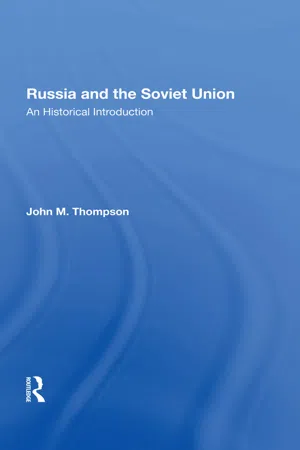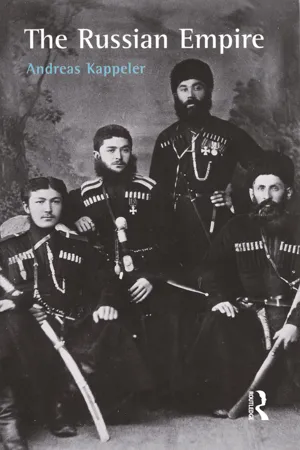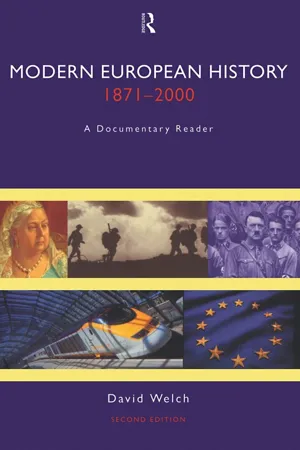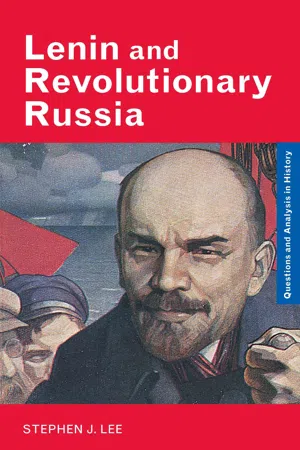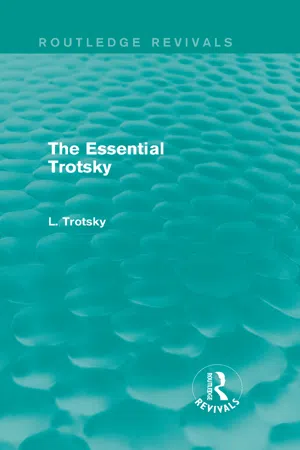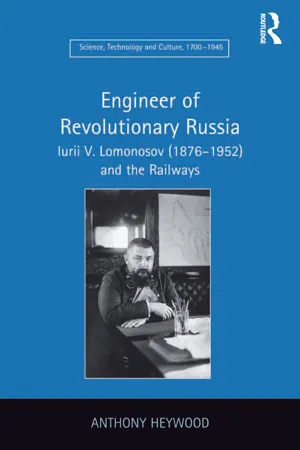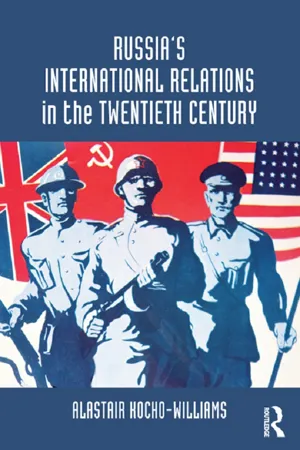History
Russian Revolution 1905
The Russian Revolution of 1905 was a wave of mass political and social unrest that spread across the Russian Empire. It was sparked by a peaceful protest march to the Tsar's Winter Palace in St. Petersburg, which ended in a violent confrontation with the Imperial Guard. The revolution led to the granting of civil liberties and the establishment of the first Russian parliament, the Duma.
Written by Perlego with AI-assistance
Related key terms
10 Key excerpts on "Russian Revolution 1905"
- eBook - ePub
Revolutions and the Revolutionary Tradition
In the West 1560-1991
- David Parker, David Parker(Authors)
- 2002(Publication Date)
- Routledge(Publisher)
It is often asked whether the events of 1905 justify their conventional description as a ‘revolution’. In terms of outcome it can be argued that little changed. The autocracy survived, modified only slightly by the existence of the State Duma. Social changes too were minimal: the main reform package, Stolypin’s agrarian legislation of 1906 onwards, which encouraged the breakup of the peasant commune, may even be regarded as counter-revolutionary, insofar as the measures which it introduced corresponded more to the interests of the government than to the demands of the peasants. Even viewed as a bourgeois-democratic revolution, 1905 was abortive and incomplete. Yet the nature of the events of 1905 must be regarded as revolutionary, with widespread resort to violence on both sides. Contemporaries had little doubt that what they were experiencing was the long-awaited revolution, even if they were eventually to conclude that its relative lack of success made it Russia’s 1848 rather than her 1789.The failure of the revolutionaries to achieve their aims has often been blamed on the weakness and divisions of the opposition to Tsarism, and especially on the inability of the socialist parties to organise and coordinate their actions and those of their supporters. While these criticisms are undoubtedly valid, a comparison with the next round of the assault on Tsarism suggests that they were not the most crucial factors. The socialist parties were little stronger during the First World War than they were in 1905, yet Tsarism was to collapse in a matter of days from the start of the first strikes and demonstrations in February 1917. This indicates that the significant difference lay not so much in the strength of the revolutionary movement as in the weakness of the state. In particular, Tsarism in 1905 retained the loyalty of sufficient troops to suppress the Revolution, and the support of senior officials and generals with the will to use them. In February 1917, as we shall see below, neither of these conditions prevailed.After 1905, a similar pattern of events unfolded to that of the post-Crimean period. The unsuccessful war was followed by a series of ‘reforms from above’ (although the post-1905 reforms, unlike those of the 1860s and 1870s, were forced from the government by a real revolutionary situation) and by a new wave of economic expansion: there was a marked revival of industrial growth from about 1908, largely stimulated by the demands of rearmament. Symptoms of a renewed and potentially revolutionary crisis appeared between 1912 and 1914, even before Russia’s disastrous involvement in another war led to a new attack on Tsarism in February 1917. - eBook - ePub
Russia And The Soviet Union
An Historical Introduction--second Edition
- John M Thompson(Author)
- 2019(Publication Date)
- Routledge(Publisher)
The early twentieth-century popular uprising against the tsarist government is known as the Revolution of 1905 because the peak of revolutionary activity occurred in that year. In fact, however, its first manifestations date to 1904, and the revolutionary movement in the countryside and in the army continued into 1907. During these years the tsarist regime faced a major challenge to its authority, the breadth and intensity of the opposition reflecting in part the enormous socioeconomic changes that had taken place in Russian society in recent decades. Comparing the Revolution of 1905 to the Decembrist Revolt only eighty years earlier, one is struck by how isolated from and unrepresentative of the whole society the Decembrists were and how by contrast almost every social group participated in the 1905 revolution.Some of the participants came from totally new classes: industrial workers and people from the professions and business. Others, such as the national minorities, were newly aroused, whereas the peasants had a long tradition of rebellion but had never acted countrywide and en masse before. Finally, mutinies in the army and navy marked the first time that military rank and file had risen against authority. The very breadth of the revolutionary forces in 1905 was also of course an element of weakness. Each group had somewhat different aims and favored different methods of struggle. Yet the wide range of revolutionary cadres—middle-class liberals, workers, peasants, non-Russian minorities, soldiers, and sailors—and the spontaneous nature of much of their antigovernment activity clearly foreshadowed the Revolution of 1917, and for these and other reasons Lenin called 1905 a “dress-rehearsal” for the more decisive uprising twelve years later.Russia’s war with Japan in 1904–5 triggered the Revolution of 1905 but did not cause it. The revolution grew out of long-standing grievances, social injustices, and political frustrations in Russian society; the strain and sacrifice of war, coupled with the humiliation of Russian losses and the country’s final defeat by Japan, provided the immediate pretext to attack the government. - eBook - ePub
The Russian Empire
A Multi-ethnic History
- Andreas Kappeler(Author)
- 2014(Publication Date)
- Routledge(Publisher)
2 This is partly due to the fact that in the Soviet Union and in other countries the social and political factors which contributed to the revolution were given priority, and that national factors were considered to be of lesser importance. This approach is certainly justifiable. National conflicts do not occur in a vacuum, and are always linked to social, political and economic antagonisms. Yet national movements have a momentum of their own that should not be underestimated. The explosive force and the magnitude of ethnically related social, political and economic conflicts of interest were once again demonstrated by events in the Soviet Union after 1988. And to a certain extent these were reminiscent of what happened in 1905 and 1917.1. The Revolution of 1905 as the Springtime of the PeoplesFifty-seven years after the revolution of 1848 Russia was at last also confronted with two tasks: the bourgeois revolution, and national emancipation. In the era of industrialization liberal and democratic demands vied with the aims of socialism, and in the revolutionary and national movements the two elements were variously intermingled. The revolution of 1905 was at one and the same time a revolution of the intelligentsia, the workers, the peasants, the soldiers, and the different nationalities. The fact that the various strands did not coalesce to become a unified revolutionary movement, and that on the whole they pursued autonomous paths of their own, can be seen as one of the primary reasons for the failure of the revolution.3The revolution began in the capital, and in the events leading up to it the movements of the liberal landowners and the radical thinkers in St Petersburg played an important role. At the same time there were important precursors on the periphery of the Russian Empire that are often overlooked. As early as 1895—1900 only three of the 59 street demonstrations recorded in the Russian Empire took place in the Russian territories, whereas 25 occurred in the Kingdom of Poland, nine in the Baltic provinces, nine in Ukraine, seven in Belorussia, and six in Finland.4 After decades of relative peace, the peasants’ movement re-emerged in Ukraine on the left bank of the Dnepr in 1902—04, and the peasant protest movement which occurred simultaneously in the socially and ethnically homogeneous Georgian area of Guria spawned a system of revolutionary self-government. The urban disturbances in 1903 and 1904 occurred first in Baku, and then spread to the whole of Transcaucasia, Ukraine and the Kingdom of Poland, where, towards the end of 1904, there were numerous demonstrations and protests against the mobilization of reservists.5 - eBook - ePub
Modern European History 1871-2000
A Documentary Reader
- David Welch(Author)
- 2003(Publication Date)
- Routledge(Publisher)
Whether or not you see the October Manifesto as a genuine policy of conciliation or an attempt to ‘buy off’ the revolutionary movement, it served to split the opposition. It proved too much for the conservatives and too little for the Social Democrats, who continued with their agitation and tried unsuccessfully to organise another strike in Moscow. Liberals were also divided between moderates, who professed satisfaction with the concessions, and became known as the Octobrist Party, and ‘progressives’ (the Constitutional Democratic Party or ‘Cadets’), who continued to demand further parliamentary reforms. Above all, the Revolution of 1905 and its comparative failure forced all opponents of the tsarist regime to reappraise the nature of revolution and the tactics they should adopt in the future. As historian James Joll has stated, the Russian Revolution of 1905 was the most impressive revolutionary outbreak in Europe since the Paris Commune, and it naturally made an enormous impression on the international socialist movement.However, before the First Duma met, its powers were curtailed when the government passed the Fundamental Laws in May 1906, which allowed the Tsar to retain his autocratic powers. The Duma was declared to be merely the lower house of a twochambered legislative body, and the Tsar would be allowed to choose and dismiss ministers as he pleased. Much of the value, then, of the concessions made in the October Manifesto were undercut by the provisions of these laws. Nevertheless, the manifesto formed the basis for the 1906 Constitution, which remained the bedrock of Russian political life until the Revolution of 1917. Indeed, it could be said that between 1906 and 1912 Russia experienced a period of relative tranquillity, due largely to reforms undertaken by Peter Stolypin, who was appointed Prime Minister in 1906.The outbreak of war was initially supported with enthusiasm in Russia. Although the tsarist regime had survived the crisis of 1905, it was vulnerable to a long-drawn out military conflict. In economic terms, Russia’s position in 1914 was characterised by low productivity in agriculture, and an uneven performance in industry. Starting from a low industrial base, some sectors had achieved considerable growth, but Russian industry was highly dependent on foreign capital, whose flow would now be interrupted by war. Moreover, Russia was ill prepared to fight a modern war; its superiority in numbers could not compensate for the fact that only 30 per cent of Russian troops were armed. As a result, Russia suffered greater casualties than any other belligerent nation. By the summer of 1917 the Russian war effort was spent. However, reports from within Russia reveal that discontent was mounting before 1917. - eBook - ePub
Revolution, Democracy, Socialism
Selected Writings of V. I. Lenin
- V. I. Lenin, Paul Le Blanc(Authors)
- 2008(Publication Date)
- Pluto Press(Publisher)
Novoya Zhizn ) Lenin bluntly restates a common Marxist rejection of religion as inconsistent with science and the intellectual achievements of the Enlightenment, and also reiterates the revolutionary-democratic demand for separation of church and state, especially important in the face of the close and official link between the tsarist regime and the Russian Orthodox Church. At the same time, he emphasises the importance of defending religious freedom (especially from state persecution), stressing the need to work with and assist religious revolutionary activists, and positively noting the acceptance of religious activists into the ranks of the RSDLP.There were many currents and counter-currents during the revolutionary year of 1905. The tsarist regime wavered between unleashing savage repression and mobilising extreme reactionary sentiments in the population through an organisation known as the Black Hundreds (which glorified the desire ‘to kill revolutionists and Jews’2 ), and on the other hand – in the face of the rising revolutionary wave of workers, peasants, and other social sectors – finally issued the ‘October Manifesto’ which seemed to promise a democratic constitution, going so far as to establish (with many limitations, to be sure) a representative assembly, the Duma. At the same time, Tsar Nicholas and those around him had no intention of actually making a transition away from monarchist autocracy, and were obviously prepared to assert their authority, violently and murderously – which they did in the bloody suppression of the uprising of the Moscow soviet in December, and in the quelling of various peasant disturbances.1905: The Beginning of the Revolution in Russia1
Geneva, Wednesday, 25 (12) January
Events of the greatest historical importance are developing in Russia. The proletariat has risen against tsarism. The proletariat was driven to revolt by the government. There can hardly be any doubt now that the government deliberately allowed the strike movement to develop and a wide demonstration to be started more or less without hindrance in order to bring matters to a point where military force could be used. Its manoeuvre was successful. Thousands of killed and wounded – such is the toll of Bloody Sunday, 9 January, in St Petersburg. The army defeated unarmed workers, women, and children. The army vanquished the enemy by shooting prostrate workers. ‘We have taught them a good lesson!’ the tsar’s henchmen and their European flunkeys from among the conservative bourgeoisie say with consummate cynicism. - eBook - ePub
- Stephen J. Lee(Author)
- 2008(Publication Date)
- Routledge(Publisher)
The most outstanding among the relics of the past, the mightiest bulwark of all this barbarism, is the tsarist autocracy. By its very nature it is bound to be hostile to any social movement, and cannot but be bitterly opposed to all the aspirations of the proletariat toward freedom.By reason of the above, the first and immediate task put before itself by the Russian Social Democratic Workers’ Party is to overthrow the tsarist autocracy and to replace it with a democratic republic …To attain its immediate goals, the Russian Social Democratic Workers’ Party will support every opposition and revolutionary movement directed against the existing social and political system in Russia.Source B: Extract from Michael Lynch, Reaction and Revolution: Russia 1881–1924 published in 1992.It is a remarkable feature of the 1905 Revolution how minor a role was played by the revolutionaries. Hardly any of them were in St Petersburg or Moscow when it began. Revolution occurred in spite of, rather than because of, them. With the exception of Trotsky, none of the SDs made an appreciable impact on the course of events. This has led many historians to doubt whether the events of 1905 merit being called a revolution. They further point to the fact that in a number of important respects tsardom emerged from the disturbances stronger rather than weaker.Source C: Extract from Sheila Fitzpatrick, The Russian Revolution , published in 1982.With hindsight it might seem that the Marxist revolutionaries, with 1905 under their belts and 1917 already looming on the horizon, should have been congratulating themselves on the workers’ spectacular revolutionary debut and looking confidently towards the future. But in fact their mood was quite different. Neither Bolsheviks nor Mensheviks had got more than a toehold in the workers’ revolution of 1905: the workers had not so much rejected as outpaced them, and this was a very sobering thought, particularly for Lenin. Revolution had come but the regime had fought back and survived.Questions
1. Using your own knowledge, explain briefly the reference in Source A to ‘tsarist autocracy’. (3) - eBook - ePub
- Leon Trotsky(Author)
- 2014(Publication Date)
- Routledge(Publisher)
The Russian Revolution
DOI: 10.4324/9781315794556-3Events at the present time succeed one another so rapidly that it is difficult to reproduce them from memory even in their simple chronological order. I have no papers or documents at hand. At the same time the periodical breaks in the negotiations at Brest-Litovsk give me a certain amount of leisure which, under present conditions, is not likely to recur. I shall, therefore, try to sketch from memory the course and development of the November Revolution, reserving to myself the right to complete and correct my narrative at some future date, with the aid of documentary evidence.What distinguished our party almost from the very first stage of the Revolution was the firm conviction that the logic of events would eventually place it in power. I am not speaking here of the theoreticians of our party, who, many years before the Revolution, even before the Revolution of 1905, had come to the conclusion, from a close analysis of the class relations in Russia, that the victorious course of a revolution would inevitably place the power of the State in the hands of the proletariat, supported by the wide masses of the poorest peasantry. The main foundation for this belief was the insignificance of the Russian middle-class democracy and the concentrated character of Russian industry, and, therefore, the immense social importance of the Russian working class. The insignificance of the Russian middle-class democracy is but the obverse side of the power and importance of the proletariat. True, the war temporarily deceived many people on this point, and, above all, it deceived the leading sections of middle-class democracy itself. The war assigned the decisive role in the Revolution to the army, and the old army was the peasantry. - eBook - ePub
Engineer of Revolutionary Russia
Iurii V. Lomonosov (1876–1952) and the Railways
- Anthony Heywood(Author)
- 2016(Publication Date)
- Routledge(Publisher)
Chapter 4The Russian Revolution of 1905The outbreak of revolution in 1905 was a moment of truth for Lomonosov, as for many of his compatriots. After months of rising political tension the regime’s ‘Bloody Sunday’ massacre of unarmed petitioners in St Petersburg on 9 January 1905 sparked a wave of protest demonstrations and strikes in Russia. For the first time, liberals and radicals made common cause against the autocracy – a crucial change for fostering a popular sense of revolutionary purpose and momentum. In this unprecedented situation Lomonosov had to decide whether actively to support the revolutionary cause in line with his student vow. In the event, he played a leading role in efforts to build liberal–socialist cooperation in Kiev, and then participated in the revolutionary activity of the Russian Social Democratic Workers’ Party (SD Party), risking his life by helping this Marxist organization to make bombs and guns.This chapter explores these personal experiences in two sections that reflect the two main phases of Lomonosov’s political activities. So doing, it also attempts to cast new light on wider issues in the history of the revolution. For example, the course of events in the provinces has had less attention from Western historians than events in St Petersburg and Moscow: what do his activities reveal about the political situation in the major city of Kiev?1 Also, it is generally thought that the regime managed to regain the political initiative in late 1905 largely because the Tsar’s Manifesto of 17 October 1905 drove a wedge between the liberal and radical camps, effectively halting their cooperation: what light does Lomonosov’s first-hand experience cast on this analysis? A third issue is the nature of political violence in late Imperial Russia: does Lomonosov’s experience help us to understand why at least some revolutionaries opted for terrorism, and in particular does it support the contention that psychological factors, not ideology, were the main reason?2 - Alastair Kocho-Williams(Author)
- 2013(Publication Date)
- Routledge(Publisher)
2 The Russian revolutions of 1917 and the Russian Civil War in international context
In February 1917 (OS) Russia underwent the first of two revolutions that year. The Tsar had lost control of his capital, and with military failure and supply shortages on the home front, Petrograd erupted into revolution. The Tsar abdicated, to be replaced by a Provisional Government, which was in turn swept aside in October 1917 in a Bolshevik-led coup. Both revolutions resonated internationally, and provoked responses from foreign governments.The two revolutions had different characteristics, both domestically and in terms of how they affected Russia’s relations with foreign powers. While the Provisional Government showed a commitment to the continuance of Russian involvement in the First World War, the Bolsheviks did not. While the February Revolution put Russia onto a democratic path in the eyes if its international partners, the Bolshevik Revolution led to a new, revolutionary regime that rejected diplomacy as a bourgeois practice and believed that a new era of revolutions would sweep over the globe.Beyond the revolutions, it is important to consider the international reactions to them. The new Soviet regime threw down a challenge on the global stage. Initial reactions were to hope that it would collapse, but when this failed to occur and Russia entered a period of civil war, the Russian Empire’s former allies intervened against the Bolsheviks in the Russian Civil War. This chapter will consider the international context of the Russian revolutions of 1917 and the Russian Civil War, and the development of the Soviets as an international power in the revolutionary period.The February Revolution and the world
The February Revolution began with the outbreak of unrest in Petrograd on 23 February 1917 (OS). Women workers protesting at food shortages directly challenged the regime, and protests grew. By the following day, Petrograd had been flooded with protestors, and when orders were given to the army to use force against the crowds on 26 February, it mutinied and began to go over to the side of the revolution. This was decisive, and the regime lost control of the capital of the Russian Empire. On 27 February, the bulk of the Tsar’s ministers were arrested, while Nicholas II set out to return to Petrograd from the front. On his arrival, the Tsar was advised to abdicate the throne. Following this advice, he abdicated on 2 March 1917, also abdicating for his son, the Tsarevich Alexei, who, as a haemophiliac, was not considered well enough to occupy the throne. Instead the imperial crown was offered to the Tsar’s brother, Grand Duke Mikhail, who duly refused to accept it and commanded the Russian people to obey the newly established Provisional Government. Nicholas II, now known as Nicholas Romanov, was placed under house arrest with his family at Tsarskoe Selo. With little resistance, the Russian Empire came to an end.- eBook - ePub
National Identity and Great-Power Status in Russia and Japan
Non-Western Challengers to the Liberal International Order
- Tadashi Anno(Author)
- 2018(Publication Date)
- Routledge(Publisher)
In contrast to Populism, Marxism came to Russia as an ideology of industrialization and Westernization. Georgii Plekhanov, the father of Russian Marxism, stressed that Russia must pass through the same developmental stages as did Western European states (Baron 1963). For backward Russia, the immediate task would be a bourgeois-capitalist revolution; a socialist revolution can occur only after extended capitalist development. The proletariat of the advanced countries were destined to play a leading role in the coming socialist transformation (Baron 1963, 164–185).Yet this view did not remain universally accepted. The mass protests and uprisings of 1905 suggested – contrary to standard theory – that Russia may be prone to revolutionary upheavals precisely because of “backwardness” and of military weakness. At a more theoretical level, the experience of 1905 showed that external events can cause domestic revolutions, irrespective of the degree of the country’s socioeconomic development . However, this insight was difficult to incorporate into the Marxist framework. As Trotsky stated in 1905, from the viewpoint of standard theory, “a revolution created by war is an impotent revolution. It arises from extraordinary forces, it is supported by external forces, and… turns out to be incapable of holding the positions captured” (Gorky 1995, 128–129). Theory taught that socialist revolution in Russia was still in the distant future. But experience suggested otherwise. The gap needed to be filled, one way or another. Lenin developed a theory that provided theoretical justification for launching a socialist revolution in “backward” Russia.The first step in this theoretical transformation was the development of Marxist theories of imperialism. While Marx and Engels had little to say on imperialism, intensification of colonial rivalry in the last third of the nineteenth century attracted the attention of Marxists, who began to develop the idea that capitalism inevitably generated imperialism and war, and that only a socialist revolution would bring about a peaceful world (Mommsen 1980, 29–65). Seen from this perspective, wars ceased to be random events, and instead became an inevitable product of capitalism.
Index pages curate the most relevant extracts from our library of academic textbooks. They’ve been created using an in-house natural language model (NLM), each adding context and meaning to key research topics.

